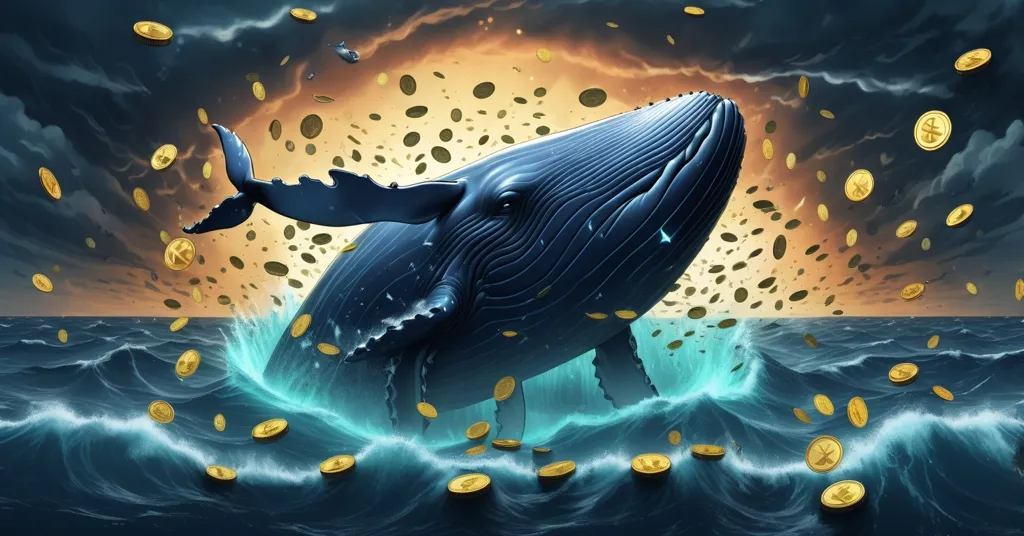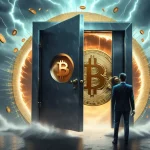XRP Recovers from $63M Whale Dump on Binance as Smart Money Buys In

XRP Shakes Off $63M Whale Dump on Binance as Smart Money Piles In
Last Friday, a staggering $63 million worth of XRP was transferred to Binance during a savage market crash, sending shockwaves through the crypto community. But instead of buckling under the pressure of a potential sell-off, XRP has staged a gritty comeback, with smart money—those savvy, deep-pocketed players—snatching up the dip like it’s a clearance sale. Are we witnessing unshakable confidence, or just a temporary reprieve before the next storm?
- Whale Shockwave: $63M XRP moved to Binance amid a market crash, sparking dump fears.
- Price Grit: XRP rebounds 1.6% to $2.50 in 24 hours with robust trading volume.
- Smart Money Bet: Heavy buying at $2 support level signals belief in XRP’s resilience.
Let’s break down the madness surrounding XRP, a cryptocurrency that’s no stranger to drama. During last week’s market bloodbath—fueled by a toxic mix of macroeconomic dread, including fears of Federal Reserve rate hikes, and a tumbling stock market—a so-called “whale” dumped $63 million worth of XRP onto Binance, the heavyweight of crypto exchanges. For newcomers, a whale is an individual or entity with a massive hoard of a cryptocurrency, capable of swaying markets with a single move. Transferring such a huge stack to an exchange often screams “sell-off,” as it hints the whale might unload their holdings, cratering the price. XRP holders braced for impact, and understandably so.
Yet, the expected collapse didn’t happen. Within 24 hours, XRP’s price edged up 1.6% to $2.50, a modest but defiant recovery. Trading volume backs this up, sitting at a healthy 4% of XRP’s total circulating market cap, showing the market isn’t asleep at the wheel. The real action happened at the $2 mark, a critical price point often called a “support zone.” Think of it as a floor where buyers historically rush in to prop up the price against sellers. Last week, buyers charged in with ferocity, suggesting that while some panicked and sold, others—likely institutional investors or seasoned traders dubbed “smart money”—saw this dip as a golden opportunity to buy low. For more on the dynamics of this whale dump and smart money moves, the details paint a fascinating picture of market resilience.
XRP’s Price Dynamics: What the Charts Reveal
Diving into the technical details, XRP rebounded off that $2 trendline with trading volume well above average, a classic sign that support is holding firm, at least for now. Another metric, the Relative Strength Index (RSI), offers a glimmer of hope. RSI is a tool traders use to gauge if a coin is overbought—priced too high and ripe for a fall—or oversold, meaning undervalued and due for a bounce. After slipping into oversold territory during the crash, XRP’s RSI has climbed back as the price hit $2.50, pointing to renewed buying interest. However, there’s a catch: XRP remains below its 200-day Exponential Moving Average (EMA), a key long-term indicator. Picture the 200-day EMA as a weather vane for market sentiment—trading below it suggests storm clouds still loom over any bullish hopes.
Analysts are watching $2.70 as the next big test. Break above that, and a push toward $3 becomes plausible. Some even speculate that clearing $3.50 could open the door to higher targets by year-end, though let’s slam the brakes on wild price predictions. Crypto is notorious for dashed dreams, and unsupported hype is something we have zero patience for. The $2 level holding is encouraging, but it’s worth noting XRP’s history—similar support zones have cracked under pressure before during past whale-driven volatility. If broader market fears, like a recession scare or renewed selling, kick in, that floor could give way faster than a house of cards.
The Flip Side: Why XRP Isn’t Out of the Woods
Before we get too cozy with optimism, let’s play devil’s advocate. Whale dumps of this magnitude aren’t just random blips—they can be calculated moves to rattle smaller investors. Spook the herd into selling low, then swoop in to buy cheaper. It’s a dirty game, and XRP’s centralized supply, with Ripple holding a hefty chunk, makes it especially vulnerable to such manipulation. Staying below the 200-day EMA isn’t a minor detail either; it signals long-term momentum isn’t with the bulls yet. And let’s not forget the broader market context—crypto often amplifies traditional finance’s woes. If last Friday’s crash, partly tied to overleveraged positions (traders borrowing too much to bet big, only to get wiped out), is any hint, another wave of fear could drag XRP down regardless of buyer grit at $2.
Ripple’s Broader Fight: Utility and Regulatory Battles
Looking beyond price swings, XRP’s story ties to Ripple, the company behind it, which is gunning to overhaul cross-border payments. For those new to this, Ripple’s tech leverages blockchain to make international money transfers faster and cheaper than clunky systems like SWIFT, often using XRP as a “bridge currency” to swap between different fiats seamlessly. It’s a bold jab at traditional finance’s inefficiencies, resonating with our push for effective accelerationism—smashing outdated systems to build something better. In a world hungry for financial freedom, that’s a mission worth cheering, even if Ripple’s tight grip on XRP’s supply clashes with decentralization purists like us.
Institutional backing adds weight to this narrative. The REX-Osprey XRP ETF (XRPR), a fund letting traditional investors tap into XRP without owning it directly, oversees over $90 million in assets and didn’t flinch during the crash, maintaining steady holdings. That’s a quiet but strong signal of confidence from big players. On the regulatory front, Ripple’s long-running clash with the U.S. Securities and Exchange Commission (SEC) shows signs of progress. A 2023 court ruling clarified that XRP sales on exchanges aren’t securities, a partial victory. If this legal cloud lifts further, institutional adoption could surge. But don’t get complacent—a single unfavorable decision could still gut XRP’s momentum. Regulatory battles are a tightrope, and Ripple’s walking it with no safety net.
Bitcoin’s Shadow: A Quick Market Check
While XRP stole the spotlight, let’s not ignore Bitcoin, the undisputed king. During the same market crash, Bitcoin dipped below $60,000 before clawing back to around $62,000. As Bitcoin maximalists, we’d argue its decentralized, scarce nature trumps XRP’s utility focus any day. Still, altcoins like XRP fill gaps Bitcoin doesn’t—think niche use cases like payments. This crash was a harsh reminder that while Bitcoin sets the tone, altcoins often swing harder, for better or worse. XRP’s resilience here is notable, but it’s still tethered to the broader market’s whims, often dictated by BTC’s moves.
Crypto Sidestep: Pepenode’s Speculative Hype
Amid the XRP turbulence, a peculiar project popped up on our radar: Pepenode ($PEPENODE). It’s pitching itself as a hardware-free meme coin mining platform, letting users “mine” tokens like Pepe ($PEPE) and Bonk ($BONK) via virtual servers—no energy-hogging rigs required. Currently in presale, it’s being marketed as an accessible entry for retail investors, available through wallets like Best Wallet. Sounds like a low-barrier way to join the meme coin craze, right? Not so fast. Meme coins are crypto’s casino—most implode spectacularly, often due to sketchy teams or zero real-world value. Pepenode’s lack of transparency, like no public audits or detailed roadmap, screams caution. Compared to XRP’s utility-driven story, this is pure speculation. If you’re tempted, treat it as a lottery ticket, not a strategy. We’re all for innovation, but scams and empty hype get no love here.
XRP at a Crossroads: Promise Meets Peril
So, where does XRP stand after this $63 million gut punch? The market’s ability to absorb the whale dump without collapsing hints at deep-rooted demand. Smart money diving in at $2 reeks of confidence, and Ripple’s mission to disrupt sluggish financial systems aligns with our drive to accelerate change, however flawed the execution. Yet, the red flags are impossible to ignore: technical fragility below the 200-day EMA, the ever-present threat of whale manipulation, and a regulatory saga that could swing either way. XRP is teetering between a breakout and a breakdown, and only time will tell which wins.
Crypto remains a brutal arena, and XRP embodies that duality—resilience paired with risk, innovation shadowed by centralization. As champions of decentralization and privacy, we see Ripple’s fight against traditional finance as a step forward, but not without serious caveats. Keep your skepticism sharp, watch those key levels like a hawk, and remember: in this space, today’s rally can be tomorrow’s rubble.
Key Questions and Takeaways on XRP and Crypto Dynamics
- What ignited the recent XRP market scare?
A $63 million transfer to Binance by a whale during last Friday’s market crash fueled fears of a massive sell-off. - Why are some still betting big on XRP despite the dump?
A 1.6% price recovery to $2.50 in 24 hours and fierce buying at the $2 support zone show smart money banking on XRP’s strength. - Which technical levels are critical for XRP’s next steps?
Breaking $2.70 could target $3, but trading below the 200-day EMA signals ongoing bearish pressure. - How are institutional investors supporting XRP amid volatility?
The REX-Osprey XRP ETF, with over $90 million in assets, held firm during the crash, reflecting steady big-player trust. - What drives XRP’s long-term outlook despite challenges?
Ripple’s push for faster cross-border payments and regulatory wins, like the 2023 SEC ruling, boost institutional interest. - What dangers still threaten XRP’s momentum?
Whale-driven volatility, technical weaknesses, and unresolved SEC battles could derail any gains in a heartbeat. - What’s Pepenode, and is it a safe play?
It’s a presale project for hardware-free meme coin mining, but its speculative nature and lack of clarity make it a risky gamble. - How does XRP connect to broader crypto ideals?
Ripple’s challenge to outdated financial systems echoes goals of decentralization and freedom, though its centralized supply remains a sticking point.



